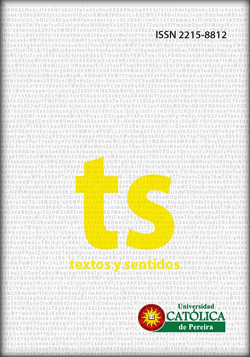Photographic stories on prevention of psychoactive substances on socially vulnerable schoolers
Keywords:
Cartography, drug addiction, resilience, socio constructivism, photographyAbstract
A research was conducted in the educational institution Las Brisas, located in the commune Villa Santana (Pereira, Colombia), motivated by three local teachers concerns for the future of the current generation of social vulnerability scenarios. Social mapping was used as context recognition technique. The aim was to describe how they got impacted by photographic stories in the prevention of psychoactive substances in children of that institution. The design was descriptive, with pretests, photography workshops and awareness resilience. The photograph moved deep down the feelings of the children expressed in different stories and allowed to outsource feelings of hope and fear, glimpsing elements in the process of drug prevention.
References
Barudy, J, y Dantagnan, M. (2005). Los buenos tratos a la Infancia. Barcelona: Gedisa.
Bernard, B. (1991). Fostering Resiliency in Kids: Protective Factors in the Family, School, and Communty. San Francisco: WestEd Regional Educational Laboratory.
Bronfenbrenner, U. (1979). Theecology of human development: Experimentsbynature and design . Cambridge, MA: Harvard UniversityPress.
Brooks R, (1992).self – Esteemduringtheschool . In: PediatricClinics of North America, 39 (3).
Cartier-Breson, Henri (2003). «El instante decisivo», en Fontcuberta, Joan (ed.) Estética fotográfi ca. Barcelona: Gustavo Gili.
Coll, C. (2007), TIC y prácticas educativas: realidades y expectativas, ponencia presentada en la XXII Semana Monográfi ca de la Educación, Madrid, Fundación Santillana.
Cyrulnik, B. (1999). Un merveilleuxMalheur.Francia: OdileJacob.
Goodman, S. H. (2007). Depression in mothers. AnnualReview of ClinicalPsychology, 3 , 107–135.
Grotberg, Edith (1995a). A guide to promotingresilience in children:strengheningthe human spirit, The International Resilience Project., Bernard Van Leer Foundation. La Haya, Holanda.
Grotberg, Edith (1995b). The Internacional ResilienceProyect: PromotingResilience in Children. ERIC: ED.383424, E.E.U.U.
Grotberg, E. (2003) Resiliencia, descubriendo las propias fortalezas”, Paidós
Habegger, S. y Mancila. I. (2006): El poder de la Cartografía Social en las Prácticascontrahegemónicas o La Cartografía Social como estrategia para diagnosticar nuestro territorio.
Hawkins, J. D., Catalano, R. F., Kosterman, R., Abbott, R. D., & Hill, K. G. (1999). Preventingadolescenthealthrisk behaviorbystrengtheningprotectionduringchildhood. Archives of Pediatrics and Adolescent Medicine, 153 , 226–234.
Hawkins, J. D. & Catalano, R. F. (1990), 20 Questions: adolescent Substance Abuse Risk Factors (material en audio). Seattle: WA, Developmental Research and Programs.
Hawkins, J. D., Catalano, R. F. & Millar, J. Y. (1992). Risk and protective factors for alcohol and other drug problems. Psychological Bulletin, 112 (1), 64-105.
Henderson, N.; Milstein, M. M. (2003): Resiliencia en la Escuela, Barcelona, Ediciones Paidós Ibérica S.A.
Hine, Lewis W. Men at Work: photographic studies of modern men and machines. Publisher: Dover Publications, 1977.
Javela, A. informe técnico y de actividades de la estratifi cación socioeconomico del municipio de Pereira del año 2008-2009-2010-2011.
Kotliarenco, M.A., Cáceres, I., Fontecilla, M. (1997) Estado del Arte en Resiliencia Organización Panamericana de la Salud, Fundación W.K.
Kellogg, Agencia Sueca de Cooperación Internacional para el Desarrollo, CEANIM. Washington D.C., Estados Unidos.
Kotliarenco, María Angélica; Cáceres, Irma; y Alvarez Catalina. Eds. (1996).
Resiliencia: Construyendo en adversidad.CEANIM, Santiago, Chile.
Matos, J. (1995). El paradigma sociocultural de L.S: Vigostky y su aplicación en la educación (mimeo). Heredia, Costa Rica: Universidad Nacional.
Mora, M. (23 de Diciembre de 2007). Hacinamiento genera gran delincuencia. El Sol de México.
OMS (1974). Comité de expertos de la OMS en farmacodependencia. Informe 20. Ginebra: OMS, P.51
Plan Nacional Decenal de Educación PNDE 2006-2016. (09 de Mayo de 2012).
Pozo, I. (2001). Humana mente. El mundo, la conciencia y la carne. Morata. Madrid. 2001.
Rirkin, M., &Hoopman, M. (1991). Movingbeyondrisk to resiliency. Minneapolis, MN: Minneapolis PublicSchools.
Riis, Jacob A. Cómo vive la otra mitad: estudios entre las casas de la vecindad de Nueva York. Barcelona: Alba, 2007.
Rutter, M. (1987). Psychosocialresilience and protectivemechanisms. American Journal of Orthopsychiatry, 57 , 316–331.
Rutter, M. A. (1985) Rescilience in theface of adversity: Protectivefactors and resistance to psychiatric desorder. Br. J. Psychiatry. Vol. 147, pp 598- 611.
Sen, A. (2000[1998]). Desarrollo y Libertad. Bogotá: Planeta.
Sen, Amartya. “Las distintas caras de la pobreza”, El País, 30 de agosto de 2000
Solnit AJ, Green M. Reactions to thethreatenedloss of child: A vulnerable Childsyndrome III. Pediatrics, 1964; 58 (July).
Vanistendael, Stefan (1995): Cómo crecer superando los percances: resiliencia capitalizar las fuerzas del individuo. International .
CatholicChild Bureau. Ginebra, Suiza.
Vigotsky, L.S. (1978). Pensamiento y lenguaje. Buenos Aires: La Pleyade.
Werner, E. E. & Smith, R. S. (1992). Overcoming the Odds: High-Risk Children from birth to adulthood. Nueva York: Cornell University Press.
Werner, E. E., & Smith, R. S. (1982). Vulnerable butinvincible: A study ofresilientchildren . New York, NY: McGraw-Hill.
Wolin, S. J. y Wolin, S. (1993). The resilient self: How survivors of troubled families rise above adversity. New York: Villard.

